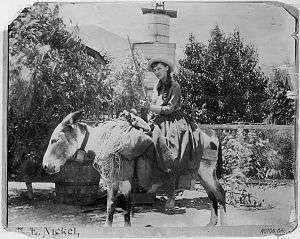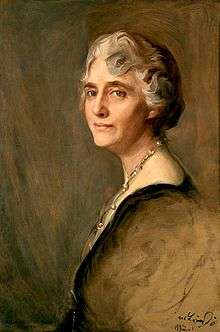Lou Henry Hoover
| Lou Henry Hoover | |
|---|---|
 | |
| First Lady of the United States | |
|
In role March 4, 1929 – March 4, 1933 | |
| President | Herbert Hoover |
| Preceded by | Grace Coolidge |
| Succeeded by | Eleanor Roosevelt |
| Personal details | |
| Born |
Lou Henry March 29, 1874 Waterloo, Iowa, U.S. |
| Died |
January 7, 1944 (aged 69) New York City, U.S. |
| Political party | Republican |
| Spouse(s) | Herbert Hoover (m. 1899) |
| Children |
Herbert Allan |
| Alma mater |
University of California, Los Angeles San Jose State University (DipEd) Stanford University (BA) |
| Signature |
|
Lou Henry Hoover (March 29, 1874 – January 7, 1944) was the wife of President of the United States Herbert Hoover and served as First Lady from 1929 to 1933.
Marrying her geologist and mining engineer husband in 1899, she traveled widely with him, including to Shanghai, China, and became a cultivated scholar and linguist. A proficient Chinese speaker, she is the only First Lady to have spoken an Asian language. She oversaw construction of the presidential retreat at Rapidan Camp in Madison County, Virginia. She was the first First Lady to make regular nationwide radio broadcasts.
Early life and education

Lou Henry was born in Waterloo, Iowa, to banker Charles Delano Henry and Florence Ida Weed.[1][2] Lou grew up something of a tomboy in Waterloo, as well as Whittier, California, and Monterey, California.[1] Charles Henry took his daughter on camping trips in the hills—her greatest pleasures in her early teens.[1] Lou became a fine horsewoman; she hunted, and preserved specimens with the skill of a taxidermist; she developed an enthusiasm for rocks, minerals, and mining.[1]
Hoover's postsecondary school began at the Los Angeles Normal School, now known as the University of California, Los Angeles. She later transferred to and graduated from San Jose Normal School, now known as San Jose State University, with a teaching credential in 1893. In 1898 she graduated—as the school's only female geology major at the time— with a B.A. in Geology at Stanford University, where she met Herbert Hoover, who was then a senior.[3]
Marriage and travels
When Herbert Hoover graduated from Stanford in June 1895, they had decided to delay wedding plans while she continued her education and he pursued his engineering career in Australia. In 1898, the year she graduated from Stanford, Hoover cabled a marriage proposal, which she promptly accepted by return wire.
Both Herbert and Lou were 24 years old when they married on February 10, 1899, at the home of the bride's parents in Monterey, California. Although raised an Episcopalian, Miss Henry decided to become a Quaker.[4] But because there was no Quaker Meeting in Monterey, they were married in a civil ceremony performed by Father Ramon Mestres, a Roman Catholic priest of the Cathedral of San Carlos Borromeo.
China
The day after their marriage, the Hoovers sailed from San Francisco for Shanghai, China, where they spent four days in the Astor House Hotel.[5] The newlyweds soon settled into their first home, a large house in Tianjin. Hoover's job required extensive travel throughout remote and dangerous areas, which they did together.[6] Mrs. Hoover was present with her husband during the Boxer Rebellion.
Mrs. Hoover learned and became proficient in Chinese. In the White House, at times, the Hoovers would converse in Chinese to foil eavesdroppers. To date, she is the only First Lady to speak an Asian language.
Mrs. Hoover was also well versed in Latin; she collaborated with her husband in translating Agricola's De Re Metallica, a 16th-century encyclopedia of mining and metallurgy. The Hoover translation was published in 1912, and remains in print today as the standard English translation. During World War I, she assisted her husband in providing relief for Belgian refugees. For her work she was decorated in 1919 by King Albert I of Belgium.
As First Lady (1929-1933)
Radio broadcasts

Mrs. Hoover distinguished herself by becoming the first First Lady to broadcast on a regular and nationwide basis. Although she did not have her own radio program, she participated as a guest speaker on a number of occasions between 1929 and 1933, often advocating for volunteerism, or discussing the work of the Girl Scouts. Radio critics praised her for having an excellent radio voice and for speaking with confidence.[7]
Presidential traditions
As First Lady, she discontinued the New Year's Day reception, the annual open house observance begun by Abigail Adams in 1801.
She played a critical role in designing and overseeing the construction of a rustic presidential retreat at Rapidan Camp in Madison County, Virginia. It was a precursor of the current presidential retreat, Camp David.
Family life
The Hoovers had two sons:
- Herbert Charles Hoover (1903–1969) - engineer, diplomat. Born in London, by age two, he had been around the world twice with his globetrotting parents. He graduated from Stanford University in 1925 and began working as an aircraft engineer. He taught briefly, from 1928 to 1929, at Harvard Business School. Eventually he turned to geophysical engineering, founding the United Geophysical Company in 1935 to develop new electronic instruments to discover oil. He served as mediator during the 1953-1954 oil dispute between Britain and Iran. He was appointed Under Secretary of State for Middle Eastern affairs 1954-1957 by President Eisenhower. He died in Pasadena, California.
- Allan Henry Hoover (1907–1993) - mining engineer and financier. Born in London, he graduated in economics from Stanford University in 1929 and earned a master's degree from the Harvard Business School in 1931. He went into banking and operated a ranch in California for a time, but eventually he, too, became a mining engineer. A private man, he shunned publicity throughout his career. He died in Portola Valley, California.
Later life and death
Lou died of a heart attack in New York City on January 7, 1944. She predeceased her husband by 20 years, and was originally buried in Palo Alto, California. Following her husband's death in 1964, she was reinterred next to the president at West Branch, Iowa.
Activities
Girl Scouts
She served as the national president of the Girl Scouts of the USA from 1922 to 1925 while Hoover served in the cabinet of Presidents Warren G. Harding and Calvin Coolidge. She served as president again after leaving the White House, from 1935 to 1937.
Camp Lou Henry Hoover in Middleville, New Jersey, is named for her and run by the Heart of New Jersey Council of the Girl Scouts.[8] She funded the construction of the first Girl Scout house in Palo Alto, California. The oldest Girl Scout house in continuous use, it is now called Lou Henry Hoover Girl Scout House.[9]
Stanford University
Lou Henry was an avidly athletic young woman, and by her senior year at the university she was a member of the Basket Ball Committee, Vice President of the Women's Athletic Association and an active member of the Archery Club.
The Lou Henry Hoover House, which she designed and where the Hoovers lived, in Palo Alto's foothills is now the official residence of the President of Stanford University. It is designated a National Historic Landmark.
Other memorials
Lou Henry Hoover Elementary School in Whittier, California was built in 1938 and was named in her honor. Lou Henry Hoover Memorial Hall built in 1948 at Whittier College, where she had been a trustee until her death, is also named for her.[10] In 2005 Lou Henry Elementary School was opened in her honor in Waterloo, Iowa. One of the brick dorms known now as "The Classics" at San Jose State University is named "Hoover Hall" in her honor.
See also
- Battle of Tientsin
- Lou Henry and Herbert Hoover House
- Lou Henry Hoover Elementary School
- Jessie De Priest tea at the White House
Notes
- 1 2 3 4 Allen
- ↑ Hart, pp. 129-33
- ↑ "Lou Hoover Biography". National First Ladies Library. Retrieved 21 June 2017.
- ↑ Gummere, pp. 6, 520-21, 571; Hart, pp. 129-33; Hill, pp. 829-32; Hynes, pp. 2-10.
The Quaker heritage of Lou Henry is extensive: beginning with William Woolman (1632-1692); passing to his son, John Woolman (1655-1718), and his wife, Elizabeth Borton (1664-1718); passing to their daughter, Elizabeth Woolman (1685-1755), aunt of Quaker preacher John Woolman (1720-1772), and her husband, Robert Hunt (died 1716); passing to their son, Robert Hunt (1709-1764), and his wife, Abigail Wood (1715-1747); passing to their son, Robert Hunt (1745-1805), and his wife, Abigail Pancoast (1743-1827); and finally passing to their daughter, Abigail Hunt (1781-1843), and her husband, William Henry (1777-1862), a member of the Methodist Episcopal church. - ↑ Allen, p. 23
- ↑ Preston
- ↑ For example, see Larry Wolters, "First Lady to Give First Talk At White House" in the Chicago Tribune, March 22, 1931, G9.
- ↑ "Camp Lou Henry Hoover History" (PDF). Girl Scouts Heart of New Jersey. Retrieved 20 January 2015.
- ↑ "Girl Scouts Palo Alto, California". Palo Alto Service Unit. Retrieved 20 January 2015.
- ↑ "Historic Campus Architecture Project: Lou Henry Hoover Memorial Hall". Council of Independent Colleges. Retrieved 20 January 2015.
References
- Allen, Anne Beiser and Jon L. Wakelyn (2000). An independent woman: the life of Lou Henry Hoover. Westport, Connecticut: Greenwood Press
- Gummere, Amelia Mott (1922). The journal and essays of John Woolman. New York: The Macmillan Company
- Hart, Craig (2004). A genealogy of the wives of the American presidents and their first two generations of descent. North Carolina, Jefferson: McFarland & Co., Inc., pp. 129–133
- Hill, H. H. (1881). History of Lee County [Illinois]. 873 pages. pp. 829–832. Genealogy and history of the Robert and Abigail Pancoast Hunt family, including a transcription of their Quaker wedding document.
- Hunt, Charles Cummins (1906). A genealogical history of the Robert and Abigail Pancoast Hunt family. Columbus, Ohio: Champlin Press, pp. 127–128
- Hynes, Judy (1997). The Descendants of John and Elizabeth (Borton) Woolman. Mount Holly, New Jersey: John Woolman Memorial Association
- Preston, Diana (2000). The Boxer Rebellion: the dramatic story of China's war on foreigners that shook the world in the Summer of 1900. New York: Walker
- Agricola's De Re Metallica, translated by Herbert Hoover and Lou Henry Hoover, full text (650 pages) and illustrations
External links
- Lou Hoover at C-SPAN's First Ladies: Influence & Image
- Herbert Hoover Presidential Library & Museum
- Biography of Lou Henry Hoover Hosted by the Herbert Hoover Presidential Library & Museum
- Lou Henry Hoover Papers
- Biographical sketch of Lou Henry Hoover Hosted by the National Archives and Records Administration
- First Lady Biography: Lou Hoover Hosted by the National First Ladies' Library
- Anne Beiser Allen and Jon L. Wakelyn; An Independent Woman: The Life of Lou Henry Hoover Greenwood Press, 2000
- Biography of William Henry, great-grandfather of Lou Henry Hoover
- Biography of Abigail Hunt, great-grandmother of Lou Henry Hoover
- Lou Henry Hoover at Find a Grave
- Works by Lou Henry Hoover at Project Gutenberg
- Works by or about Lou Henry Hoover at Internet Archive
| Awards and achievements | ||
|---|---|---|
| Preceded by George Baker |
Cover of Time April 21, 1924 |
Succeeded by Gelasio Caetani |
| Honorary titles | ||
| Preceded by Grace Coolidge |
First Lady of the United States 1929–1933 |
Succeeded by Eleanor Roosevelt |

